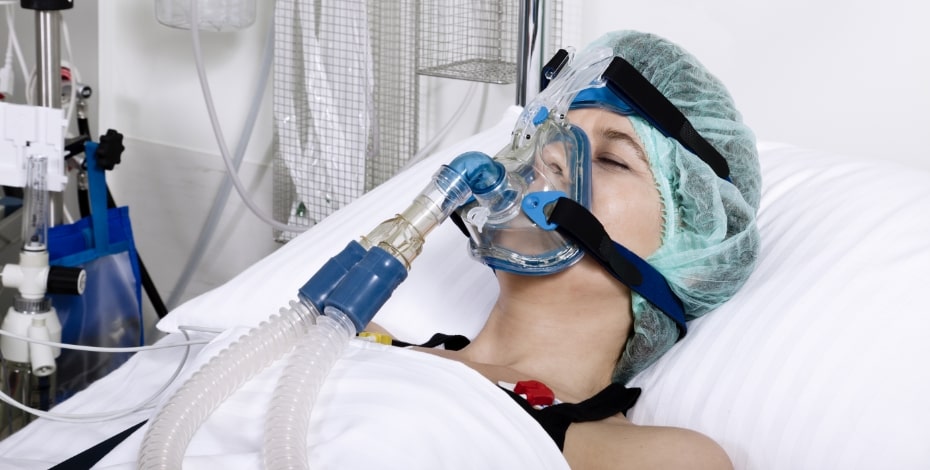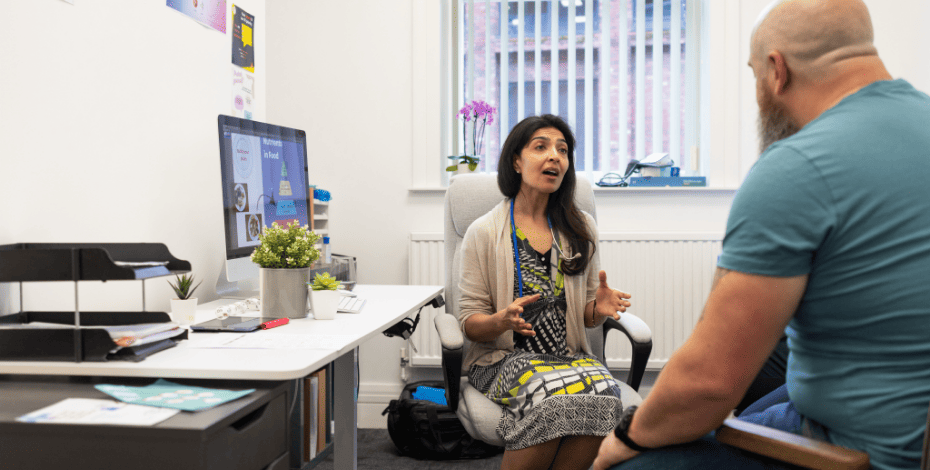
Resistance training for weak lungs

Bernie Bissett is researching ways to help ICU patients breathe again after mechanical ventilation.
More than 50 per cent of patients admitted to intensive care units (ICUs) in Australia and New Zealand each year require mechanical ventilation.
Being on a mechanical ventilator for as little as 24 hours can weaken the inspiratory muscles and the process of weaning patients off mechanical ventilation can be difficult, leading to a prolonged stay in ICU.
Some patients experience breathlessness for several years after their ICU stay due to ongoing inspiratory muscle weakness.
Canberra-based physiotherapist and researcher Professor Bernie Bissett APAM has been working on ways to strengthen the inspiratory muscles for around 15 years, after realising that ICU patients were getting stuck on ventilators because their breathing muscles had become weak while the ventilator did all the work of breathing for them.
‘We started playing around with doing strengthening work specifically for their breathing muscles.
‘At that time this was not something that physios were doing around the world.
‘The idea of disconnecting a patient from the ventilator and getting them to do even a few breaths against resistance was quite out there,’ Bernie says.
She came up with a simple spring-loaded device—an inspiratory muscle trainer—that provided measurable resistance that could be increased as the patient’s inspiratory muscle strength improved.
But while the studies had promising results, the initial inspiratory muscle training (IMT) devices were not capable of providing a low enough resistance for some patients.
The lowest training limit, measured as nine centimetres of water column (cmH2O), was too strong for the weakest patients, who might have a maximum inspiratory pressure of just 10 cmH2O.
‘You can imagine that asking someone to work at 90 per cent of their maximum is a really big ask.
‘We were trying to work at 50 per cent of their maximum so they were getting some strength training benefits, but it was a real deal-breaker for quite a lot of our patients,’ she says.
Even so, studies demonstrated that IMT was safe and feasible in ICU patients.
A randomised controlled trial showed that two weeks of IMT in ICU patients resulted in stronger inspiratory muscles and an improved quality of life (Bissett et al 2022).
This inspired Bernie and her colleagues to look at a more sophisticated electronic IMT (eIMT) device, with a much broader range of training resistance.
‘We thought, “Well, that’s more room to move for our really weak patients”.
‘As tempting as it was to jump in and go, “Right, let’s do a randomised trial. Let’s do this”, we recognised that we needed to do the basics first.
‘The basics included establishing that it was feasible to use in ICU patients, that it was safe to use this device and that it was acceptable from the patient perspective,’ Bernie says.
The patient perspective was an important aspect of the resulting study, which was funded by a Jill Nosworthy Grant from the Physiotherapy Research Foundation.
‘There has been an evolution in the research world about prioritising the patient perspective in what we’re analysing.
‘I think going to our patients and getting their views on the experience of doing this training is different and important,’ Bernie says.
The study, which was published in Australian Critical Care earlier this year (Nickels et al 2023), looked at the feasibility, safety and patient acceptability of the eIMT in ICU patients in two hospitals, Canberra Hospital in the Australian Capital Territory and Princess Alexandra Hospital in Brisbane, Queensland.
The study cohort consisted of 40 ICU patients who had experienced invasive mechanical ventilation via an endotracheal tube or tracheostomy for at least five days and who could actively participate in the training for at least two days.
Training sessions with the eIMT devices were held daily on weekdays and were conducted by physiotherapists with the assistance of the bedside nurse to minimise sedation and optimise alertness before each training session.
The training session comprised five sets of six breaths at the maximum tolerable load, with rests in between sets, a process that typically took less than 10 minutes.
Once a patient was discharged from the ICU, the training sessions ceased.

Professor Bernie Bissett has demonstrated that an electronic IMT device is safe and feasible for use in ICU patients.
Notably, around 40 per cent of the patients in the study commenced training at a level lower than nine cmH2O, which would have made them ineligible to use the older spring-loaded IMT devices.
The results showed that the use of eIMT was both feasible and safe, with 81 per cent of the planned IMT sessions completed.
Minor adverse events, such as increased blood pressure or heart rate, occurred in about 10 per cent of the training sessions and were transient, resolving soon after the training session finished without clinical consequence.
Some of the participants were also asked to complete an acceptability questionnaire, looking at burden, perceived effectiveness and general acceptability.
The majority of those who completed it felt that the eIMT sessions were beneficial, assisted their recovery and improved their feelings of wellbeing.
‘That matches our previous studies, where we’ve shown that those who participated in the respiratory muscle training, even with the old device, had quality of life changes, not just strength changes.
‘We have speculated that maybe there’s a sense of mastery that these really sick patients have, that maybe at a time when lots of other things are making very slow progress, if any, they can sense that objective improvement with their breathing muscles—“Okay, so yesterday we were training at 10 centimetres of water; now we’re training at 14”,’ Bernie says.
While the study was not designed to measure improvements in strength as an outcome, the data showed that the patients did improve their inspiratory muscle strength over the course of the study.
The median initial maximum inspiratory pressure was 22 cmH2O, while the median final maximum inspiratory pressure was around 35 cmH2O (a normal measure of maximum inspiratory pressure would be up around 90–100 cmH2O).
‘It’s getting us moving in the right direction for someone who’s quite weak to start with.
‘It was certainly in the ballpark of what we were expecting and not dissimilar to what we were seeing with the old device,’ Bernie says.
Now that the eIMT intervention has been shown to be feasible, safe and acceptable to patients, Bernie and her colleagues are planning the next study, a randomised controlled trial investigating the effectiveness of the eIMT.
‘We’ve invested the time and energy to make sure that it is going to be meaningful—we want our results to transfer to lots of different settings.
‘We’ve got hospitals from right around Australia.
‘We’re thinking that about 15 centres would be great.
‘We’d love to get a total of about 200 patients to give us a real spectrum of different backgrounds, history and presentations and because we think those kinds of numbers will allow us to have the statistical power to see changes, not just in strength but also in their quality of life, which, again, we think is probably pretty important,’ Bernie says.
The forthcoming trial will be longer, too—not just for the period of time that the patients are in ICU, but also on the ward and once they go home, for a total of about six weeks.
‘All of our studies so far have been really short-term.
‘This time we’re going to do it differently.
‘We’re going to start it in ICU as soon as they are well enough and we want to keep going for six weeks because we suspect that in measuring for two weeks, we’re only getting a glimpse of the benefits.
‘When patients go home, they’ve probably recovered half of their breathing muscle strength but there’s still work to do.
‘Imagine if they were empowered to continue that training at home.
‘It’s not particularly difficult; they can literally sit in a chair watching television while doing their training,’ Bernie says.
While there are still a lot of pieces yet to fall into place, including supplying all of the hospitals taking part in the study with eIMT devices, the research team hopes to get recruitment up and running by the beginning of 2024.
Ultimately, Bernie says, the use of IMT will improve patient care, giving physiotherapists working in ICU another tool to help their patients recover.
And its utility may extend beyond the ICU into post-ICU care.
‘I’ve also got some community physios in Canberra who have taken this technique and are using it in some of their clients with long COVID who still have residual breathlessness.
‘It’s certainly not just an ICU thing.’
>> Bernie Bissett will be presenting her eIMT study at the APA national conference IGNITE 2023 this month.
>> Click here for references. For an infographic outlining the results of the eIMT feasibility study click here.
© Copyright 2025 by Australian Physiotherapy Association. All rights reserved.





